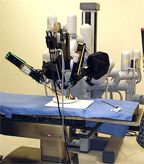Low-Risk Prostate Cancer: Model Validates Surveillance Over Treatment
Using available data from published studies, researchers found that the advantage for men treated for early low-risk prostate cancer with radical prostatectomy have only a two or three month advantage compared to those who are actively monitored.
Using available data from published studies, researchers developed a model which predicts men who are actively treated for their low-risk prostate cancer do not have a substantial extension of life compared to men followed with surveillance.

The patient-side cart of the da Vinci laparoscopic robotic surgical system, used in robot-assisted radical prostatectomies; source: Nimur, Wikimedia Commons
The model was developed by Ruth Etzioni, PhD, a biostatistician at the division of public health sciences at Fred Hutchinson Cancer Research Center in Seattle, and colleagues and shows that the advantage for men with early low-risk prostate cancer who are treated with a radical prostatectomy have, at best, a 2- or 3-month advantage compared to those who are actively monitored. The results are published in Clinical Cancer Research, a journal of the American Association for Cancer Research.
“Based on the model, we project that men with low-risk prostate cancer who opt for active surveillance can expect a very low risk of death from prostate cancer, and one that is only slightly higher than the risk under immediate treatment,” said Etzioni. “But for this increase in risk they get a much longer time without treatment, and many of them will not ever undergo treatment.”
Support for active surveillance recently came from the long-term, large PIVOT study, recently published in the New England Journal of Medicine. The 12-year results showed that older men with low-risk and low-volume disease, should be considered for active surveillance rather than radical prostatectomy to avoid unnecessary side effects. The survival of men who underwent surgery was not significantly longer compared to those men who were not treated for their cancer.
“These results are not unexpected-from what we know about low-risk prostate cancer, it is not surprising that active surveillance would be expected to yield similar survival to immediate active treatment,” said Tomasz M. Beer, MD, chair of prostate cancer research at the Oregon Health and Science University Knight Cancer Institute and author of the recent book, Cancer Clinical Trials: A Commonsense Guide to Experimental Cancer Therapies and Clinical Trials. “It is important to note that this is a modeling analysis and not a randomized prospective trial, so the results are encouraging for active surveillance, but would not be viewed as level 1 gold-standard medical evidence,” he added.
The Prostate Cancer Simulation Model and Results
In the current study, the simulation model used data from an active surveillance cohort of 769 patients at Johns Hopkins, over 3,470 patients in the CapSURE database of patients who had a radical prostatectomy, and a 963 patient cohort also from Johns Hopkins, whose disease recurred after a radical prostatectomy. The analysis output is for a hypothetical cohort of men with low-risk prostate cancer who are between the ages of 40 and 90 with a Gleason score of 6 and prostate-specific antigen (PSA) level of 10 ng/mL.
Based on these input data, the model predicts 1.6% of men who have a radical prostatectomy will die from prostate cancer in 20 years, compared with 2.8% of men who are monitored but not treated. The average life extension for men who have the surgery was 1.8 months.
Another way to understand the results is as a matter of life or death and not as an average benefit, according to Beer. “There is probably a benefit to 1 or 2 patients out of 100, and these men derive a lot of benefit, and there is probably no benefit for anyone else,” said Beer.
Supporting the better quality of life for those who do not have surgery for their low-risk prostate cancer upon diagnosis, the model projects that men on active surveillance will have an additional 6.4 years without treatment compared to those who are treated upon diagnosis.
These results are similar to those found in the PIVOT trial-a modest absolute difference in 12-year prostate cancer mortality. The 2011 National Institutes of Health Consensus Conference on Active Surveillance found active surveillance to be a valid option for those prostate cancer patients that have low-risk cancer. The issue is there is still relatively few data because of the number of years it takes to measure the effect of treatment vs no treatment on death.
Etzioni and the other authors are of the opinion that prospective and randomized trials are not feasible to answer the concerns of the true difference in quality of life and overall survival with active surveillance compared to surgery. However, Beer believes that randomized studies that compare active surveillance to immediate treatment would “yield gold standard evidence.”
How many prostate cancer patients currently opt for active surveillance over treatment? Beer believes that active surveillance is without question already a part of the approach for newly diagnosed prostate cancer patients. Statistical data is not yet available, but a recent study does suggest a multidisciplinary care team results in higher recommendations of active surveillance.
“My sense is that there is a growing consensus among clinicians that we need to be more conservative in treating the many PSA-detected prostate cancers that have low to very low risk of prostate cancer death,” said Etzioni. “I am not sure if this result will be enough to convince clinicians who are not already convinced,” she added.